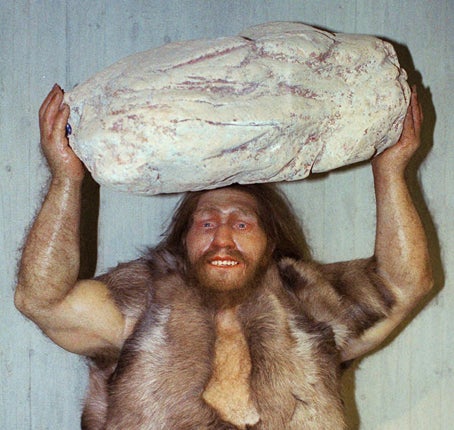
The point about science is that it provides the best tools we have for discovering the truth about the world around us, but this doesn't of course mean that it can always give us simple answers to big questions.
Take the long-running debate over the Neanderthals, the species Homo neanderthalis, the last close relative of our own tribe, Homo sapiens, to go extinct. The question is whether the Neanderthals were a just a distant relative – an evolutionary dead end who did not interbreed with anatomically modern humans – or whether they were indeed part of our direct ancestry.
Soon after the first bones of the Neanderthals were found in the Neander Valley of Germany in 1856, scientists proposed that they were the immediate "cavemen" ancestors of present-day Europeans. It fitted in with Darwinian theory and the idea of a progressive, linear line of ascent, from apeman to modern man – a notion that is now disabused as a hopelessly simplistic view of our complex family tree.
But the thing about science is that it never stops raising fresh questions that can constantly undermine the comfortable scientific orthodoxy. The carbon dating showed that Neanderthals lived in Eurasia for tens of thousands of years before anatomically modern humans arrived there from their migration out of Africa. But then it emerged that for thousands of years the two species occupied the same territory, and even the same cave systems – but almost certainly not at the same time.
The archaeology suggested little interaction between early, anatomically modern Homo sapiens, known as Cro-Magnon man in Europe, and the seemingly less sophisticated Neanderthals. Anatomically, the stocky Neanderthals with their beetle-brows, flared rib cages and short limbs seemed no match to the gracile moderns with their clever tool making and arty body ornaments.
Although it became clear that the Neanderthals were not the direct ancestor of Homo sapiens, scientists were split on just how the two species interacted when they presumably lived cheek by jowl for thousands of years. The alternatives were memorably summed up by anthropologist Erik Trinkaus of Washington University: making war or making whoopee.
The latest study aimed at answering this question suggests the latter – when Neanderthal man met Homo sapiens woman it resulted in what scientists euphemistically call "gene flow". It seems that this interbreeding, which probably took place somewhere in the Middle East when the first modern humans migrated out of Africa, has resulted in a little bit of Neanderthal in all of us today with a non-African ancestry.
We know this because this remarkable piece of research has extracted fragments of DNA from Neanderthal bones dating to 40,000 years ago and, even more remarkably, the scientists involved, led by the legendary Svante Paabo of the Max Planck Institute for Evolutionary Anthropology in Leipzig, constructed about 60 per cent of the full Neanderthal genome, the 3bn chemical bases that make up the entire DNA code. This enabled them to compare the Neanderthal genome with that of five modern-day people from around the world, and, to Paabo's astonishment, Neanderthal DNA sequences were found in the genomes of the three people who lived outside Africa. Paabo freely admits that he was biased against such a finding. His earlier work on mitochondrial DNA suggested no such interbreeding between Neanderthals and modern humans, so his initial reaction was that the data had to be a statistical fluke, or erroneous.
But it is a measure of greatness in science if you can accept something that you had previously rejected, when faced with new and convincing evidence.
Comparisons between the genomes of modern humans and the Neanderthals clearly indicated that there was a small but significant amount of interbreeding early in the evolutionary history of Homo sapiens, most probably after our species had first emerged from Africa between about 80,000 and 50,000 years ago. Other scientists, such as Professor Joao Zilhao of Bristol University, who has long argued that there was close cultural and biological interaction between Neanderthals and modern humans, can rightly feel vindicated for their somewhat unfashionable stance.
The latest twist in the Neanderthal saga may not have answered all the questions about our last close relatives, but it appears to have resolved the long-running dispute over the question of interbreeding. At the moment, however, we can only speculate about the precise social and cultural nature of this sexual interaction between these two branches of the human family tree.
Like many people, I stand in awe of Professor Stephen Hawking, but I can't help but feel that we take him too seriously when he pontificates beyond his immediate specialism of cosmological theory. Hawking has said, for instance, that our only hope for long-term survival is to built spaceships that can travel to other planets. Now he has suggested that intelligent aliens may be out there lurking in massive spaceships waiting to colonise planets such as Earth which have coveted natural resources. Such comments only go to show that when experts stray beyond what they know their insights are no better than those of the rest of us.
Subscribe to Independent Premium to bookmark this article
Want to bookmark your favourite articles and stories to read or reference later? Start your Independent Premium subscription today.

Join our commenting forum
Join thought-provoking conversations, follow other Independent readers and see their replies